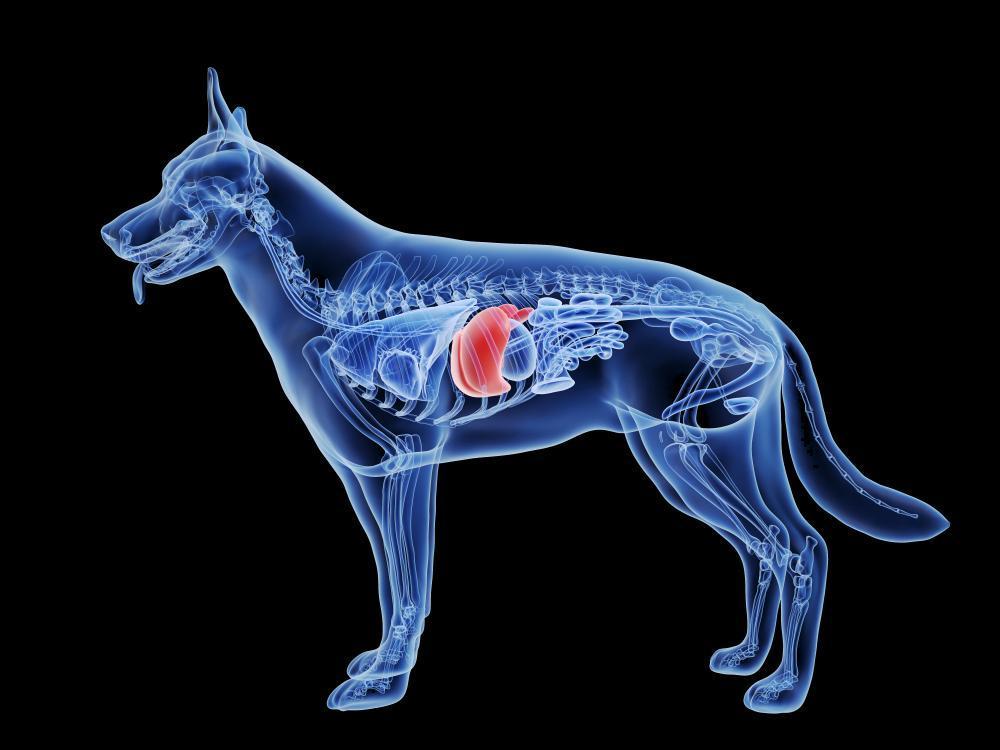-
£19.99

What Could Cause Elevated Liver Enzymes in My Dog?
- May 17, 2022
- 6 mins 4 secs
When establishing the health status of pets, we often pursue a battery of tests. Whilst they may have been explained, you won’t be the first one to wonder what exactly the tests measure and what the numbers mean.
One of the most common tests, along with kidney, is liver function. These tests are then talked about in terms of liver enzymes. But what are these liver enzymes and what jobs do they carry out in the body?
Here at My Pet Nutritionist we thought we’d compile a brief guide to liver enzyme function.
But before we get cracking, we need to understand a little more about the liver.
Blood coming from digestive organs flows through the portal vein to the liver, carrying nutrients, medication, and toxic substances. Once they reach the liver, these substances are processed, stored, altered, detoxified, and passed back into the blood or released in the bowel to be eliminated.
In this way, for us humans the liver can remove alcohol from our blood and for both us and our pets, it can get rid of by-products from the breakdown of medications and more!
Another function of the liver, with the help of vitamin K, it produces proteins that are important in blood clotting. It is also one of the organs that break down old or damaged blood cells.
To carry out its job effectively, the liver has enzymes.
Enzymes are found in liver cells, so the reason you may have heard of elevated enzymes is because damaged or inflamed liver cells can release enzymes into the bloodstream, of which a blood test picks up.
ALT, which stands for alanine transaminase, is an enzyme found mostly in the liver. It helps break down proteins for the body to absorb, and therefore also plays a role in converting food into energy in the body. When liver cells are damaged, they release ALT into the bloodstream.
In short, GGT plays an important role in cellular defence. This is why GGT levels are often elevated in cases of environmental toxicity.
It was thought that the adjuvant aluminum hydroxide played a role in cell apoptosis. It’s important to acknowledge that this study was carried out on mice, but that’s largely because researchers aren’t queuing up to dissect canine livers after they’ve had a vaccine, thankfully! But it’s important to note that this adjuvant can be found in some vaccines administered to pets.
In 1952, an outbreak of fatal liver disease in dogs occurred in the southeastern United States. The disease, termed hepatitis X, was characterised by icterus, lethargy, anorexia, petechiae, epistaxis, and hematemesis.
Affected dogs died one to 14 days after clinical presentation. The postmortem findings of hepatitis X were noted to be similar to those in swine and cattle after ingestion of mouldy corn.
The disease resulted from exposure to aflatoxins produced by the fungus Aspergillus species. In 1959, the role of aflatoxins in hepatitis X was confirmed when a group of dogs acquired the disease after being fed purified aflatoxin.
Outbreaks of aflatoxicosis sadly do occur. In 2005, there were a number of acute outbreaks of hepatic failure in dogs across the United States which raised suspicion of a food-related toxicosis.
Postmortem examination of the affected dogs revealed severe liver damage suggestive of aflatoxicosis.
Affected dogs consumed food produced by a single manufacturer. Analysis of the pet food confirmed contamination with aflatoxins. The manufacturer issued a recall, and the FDA released an alert, but over the course of the next few weeks more than 100 dogs became intoxicated and died.
In short, the enzymes in the liver convert the AF into a reactive oxygen species which can then bind to proteins. This binding is what can result in toxicity. They also bind to DNA causing DNA damage and bind to albumin in the blood, which is thought to be the reason for the poor excretion of the toxic compound (leading to build up).
Cereals present an important risk for the health of dogs because they are vulnerable to contamination by AF both in the field and in storage.
Findings Here
In humans, we know that metabolic syndrome boasts elevated liver enzymes, can we apply this to dogs?
In 2011, researchers established that various liver enzymes are elevated in the obese dog.
The results indicated that ALT and GGT may have major pathophysiological roles in obesity-related metabolic alterations and should be included as biochemical criteria of metabolic syndrome in canine obesity.
Findings Here
To learn more about obesity, and to find out our top tips on maintaining a lean body mass for your dog, check out our blogs below.
Obesity In Pets – Part One
Obesity in Pets – Part Two
If you’d like to learn more about liver issues, check out some of our blogs below:
Liver Shunts In Dogs
Ultimate Natural Guide for Pets: Liver Disease
We would advocate a fresh food diet whilst limiting exposure to harmful compounds.
Some of our home cooked recipes above may be suitable but we offer a thorough exploration of what’s going on for your pet with a personalised plan, so head over to our services and consider going through the consultation process.
Thanks for reading,
MPN Team
One of the most common tests, along with kidney, is liver function. These tests are then talked about in terms of liver enzymes. But what are these liver enzymes and what jobs do they carry out in the body?
Here at My Pet Nutritionist we thought we’d compile a brief guide to liver enzyme function.
But before we get cracking, we need to understand a little more about the liver.
What is the liver?
The liver is one of the largest organs in the body and we call it the powerhouse for good reason. It has some incredible metabolic functions.- It converts the nutrients in the diet into substances that the body can use, stores these substances, and supplies cells with them when needed.
- It also takes up toxic substances and converts them into harmless substances or makes sure they are released from the body.
How does it work?
Liver tissue is made up of lots of smaller units of liver cells called lobules. Many canals carrying blood and bile run between the liver cells.Blood coming from digestive organs flows through the portal vein to the liver, carrying nutrients, medication, and toxic substances. Once they reach the liver, these substances are processed, stored, altered, detoxified, and passed back into the blood or released in the bowel to be eliminated.
In this way, for us humans the liver can remove alcohol from our blood and for both us and our pets, it can get rid of by-products from the breakdown of medications and more!
Another function of the liver, with the help of vitamin K, it produces proteins that are important in blood clotting. It is also one of the organs that break down old or damaged blood cells.
To carry out its job effectively, the liver has enzymes.
What are enzymes?
Enzymes are proteins that speed up processes in the body, you’ll probably be familiar with digestive enzymes; these are compounds which speed up the digestion of food. So, liver enzymes speed up the processes the liver carries out.Enzymes are found in liver cells, so the reason you may have heard of elevated enzymes is because damaged or inflamed liver cells can release enzymes into the bloodstream, of which a blood test picks up.
What are the liver enzymes?
Aspartate aminotransferase (AST)
AST is an enzyme found mostly in the heart and liver and to a lesser extent in skeletal muscle. It plays a role in amino acid metabolism – transferring amino groups. When heart, liver or muscle cells are injured, they release AST into the bloodstream.ALT, which stands for alanine transaminase, is an enzyme found mostly in the liver. It helps break down proteins for the body to absorb, and therefore also plays a role in converting food into energy in the body. When liver cells are damaged, they release ALT into the bloodstream.
Alkaline phosphatase (ALP)
ALP is an enzyme found in the liver and bone and is important for breaking down proteins. Higher-than-normal levels of ALP may indicate liver damage or disease.Gamma glutamyl transferase (GGT)
GGT is an enzyme found throughout the body, but it is mostly found in the liver. GGT is typically the first liver enzyme to increase in the blood when any liver bile ducts become blocked or constricted. The primary role of GGT is the extracellular catabolism of glutathione, the major thiol antioxidant in cells, therefore playing a significant role in protecting cells against oxidants produced during normal metabolism.In short, GGT plays an important role in cellular defence. This is why GGT levels are often elevated in cases of environmental toxicity.
Low Fat Venison
What can cause elevated enzyme levels?
All dogs should be assessed individually, but there are some common themes which contribute to higher enzyme levels than the general canine population.Certain Medications
As the liver plays such a role in the metabolism and detoxification of medications, we often find that certain medications can contribute to higher-than-normal levels.Vaccine Adjuvants
A study carried out in 2012 established an apoptotic effect of the hepatitis B vaccine in the mouse liver. What this means is that after vaccine administration, cell death occurred in the liver. As we know, damage to cells in the liver can result in enzymes being released into the bloodstream.It was thought that the adjuvant aluminum hydroxide played a role in cell apoptosis. It’s important to acknowledge that this study was carried out on mice, but that’s largely because researchers aren’t queuing up to dissect canine livers after they’ve had a vaccine, thankfully! But it’s important to note that this adjuvant can be found in some vaccines administered to pets.
Food
Aflatoxins (AF) found in food have been associated with increased biomarkers in liver function and oxidative stress. Aflatoxins are found in cereals and nuts and we can head back to 1952 to understand the true risk of them.In 1952, an outbreak of fatal liver disease in dogs occurred in the southeastern United States. The disease, termed hepatitis X, was characterised by icterus, lethargy, anorexia, petechiae, epistaxis, and hematemesis.
Affected dogs died one to 14 days after clinical presentation. The postmortem findings of hepatitis X were noted to be similar to those in swine and cattle after ingestion of mouldy corn.
The disease resulted from exposure to aflatoxins produced by the fungus Aspergillus species. In 1959, the role of aflatoxins in hepatitis X was confirmed when a group of dogs acquired the disease after being fed purified aflatoxin.
Outbreaks of aflatoxicosis sadly do occur. In 2005, there were a number of acute outbreaks of hepatic failure in dogs across the United States which raised suspicion of a food-related toxicosis.
Postmortem examination of the affected dogs revealed severe liver damage suggestive of aflatoxicosis.
Affected dogs consumed food produced by a single manufacturer. Analysis of the pet food confirmed contamination with aflatoxins. The manufacturer issued a recall, and the FDA released an alert, but over the course of the next few weeks more than 100 dogs became intoxicated and died.
How does it happen?
In various tissues, especially in the liver and kidneys, AF are biotransformed and bioactivated by isoenzymes of the multiple function oxidase system or cytochromes.In short, the enzymes in the liver convert the AF into a reactive oxygen species which can then bind to proteins. This binding is what can result in toxicity. They also bind to DNA causing DNA damage and bind to albumin in the blood, which is thought to be the reason for the poor excretion of the toxic compound (leading to build up).
Cereals present an important risk for the health of dogs because they are vulnerable to contamination by AF both in the field and in storage.
Findings Here
Obesity
Metabolic changes accompanying obesity have been intensively studied in humans but are rarely reported in animals.In humans, we know that metabolic syndrome boasts elevated liver enzymes, can we apply this to dogs?
In 2011, researchers established that various liver enzymes are elevated in the obese dog.
The results indicated that ALT and GGT may have major pathophysiological roles in obesity-related metabolic alterations and should be included as biochemical criteria of metabolic syndrome in canine obesity.
Findings Here
To learn more about obesity, and to find out our top tips on maintaining a lean body mass for your dog, check out our blogs below.
Obesity In Pets – Part One
Obesity in Pets – Part Two
Liver Issues
It goes without saying that the reason we have elevated enzymes in the blood is because there’s something not quite right with the liver cells and therefore function.If you’d like to learn more about liver issues, check out some of our blogs below:
Liver Shunts In Dogs
Ultimate Natural Guide for Pets: Liver Disease
What Can I Do About Elevated Liver Enzymes?
The reason behind your dog’s enzyme discrepancy could be a number of things, it’s therefore essential to get to the root cause.We would advocate a fresh food diet whilst limiting exposure to harmful compounds.
Low Copper
Some of our home cooked recipes above may be suitable but we offer a thorough exploration of what’s going on for your pet with a personalised plan, so head over to our services and consider going through the consultation process.
Thanks for reading,
MPN Team
Customer Reviews
Explore related products
Explore Related Products
Related articles

Disease ManagementLiver Health
Why Cooked Food is Best for Your Pet’s Kidney and Liver Disease
May 30 2024
•
6 mins 55 secs

Disease ManagementLiver Health
How to Support Liver Disease Naturally
Dec 21 2023
•
8 mins 30 secs

Disease ManagementLiver Health
Can Diet Cause Raised Liver Enzymes?
Nov 16 2023
•
6 mins 20 secs

Disease ManagementLiver Health
Why Does My Dog Urinate So Much?
Dec 08 2022
•
5 mins 30 secs

Disease ManagementLiver Health
How To Support My Dog’s Liver Shunt
Jun 20 2022
•
4 mins 46 secs

Disease ManagementLiver Health
Does the Breed of My Dog Influence their Test Results?
May 19 2022
•
2 mins 56 secs

Disease ManagementLiver Health
What Could Cause Elevated Liver Enzymes in My Dog?
May 17 2022
•
6 mins 4 secs

Disease ManagementLiver Health
4 Superfoods for Liver Health in Dogs
Jan 19 2022
•
4 mins 15 secs

Disease ManagementLiver Health
A Brief Guide to Liver Function in Pets
Jan 17 2022
•
4 mins 16 secs

Disease ManagementLiver Health
Why Does My Dog Need Minerals – Part Two
Sep 23 2021
•
12 min read

Disease ManagementLiver Health
Why Does My Dog Need Minerals – Part One
Sep 22 2021
•
7 min read

Disease ManagementLiver Health
Bacterial Overgrowth – More Common Than You Think
Aug 04 2021
•
6 min read

Disease ManagementLiver Health
The Lowdown on Liver Shunts in Dogs
Jun 28 2021
•
6 min read

Disease ManagementLiver Health
5 Reasons Your Dog May Have Bad Breath
Nov 30 2020
•
7 min read

Disease ManagementLiver Health
Does My Dog Have a Vitamin Deficiency?
May 04 2020
•
15 min read

Disease ManagementLiver Health
Ultimate Natural Guide for Pets: Liver Disease
Apr 30 2020
•
15 min

Disease ManagementLiver Health
7 Top Reasons to use Clay in your Dog’s Diet Regime
Feb 20 2020
•
5 min read

Disease ManagementLiver Health
Itching has become such an epidemic
Feb 18 2020
•
6 min read
✕





















